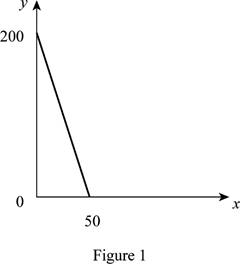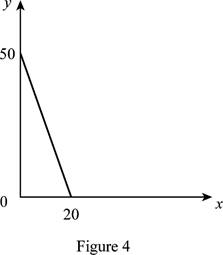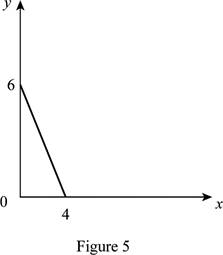
Sketch the budget constraint.
Explanation of Solution
Maximum unit of good Y (0 unit of good X is purchased) that a person can purchase with the given income and price can be calculated by using the following formula:
Substitute the respective values in Equation (1) to calculate the maximum unit of Y that can be purchased.
The maximum unit of Y is 200 units.
Maximum unit of good X (0 unit of good Y is purchased) that a person can purchase with the given income and price can be calculated by using the following formula:
Substitute the respective values in Equation (2) to calculate the maximum unit of X that can be purchased.
The maximum unit of X is 50 units.
Option (a):
Figure 1 shows the budget constraint of case “a”.

In Figure 1, the vertical axis measures the price of good Y and horizontal axis measures the price of good X. The downward sloping cure is the budget constrain of the household.
Option (b):
The maximum quantity of good X and Y is 25 and 40 respectively that is obtained by using Equation (1) and (2).
Figure 2 shows the budget constraint of case “b”.

In Figure 2, the vertical axis measure price of good Y and horizontal axis measures price of good X. The downward sloping cure is the budget constrain of the household.
Option (c):
The maximum quantity of good X and Y is 40 and 5, respectively that is obtained by using Equation (1) and (2).
Figure 3 shows the budget constraint of case “c”.

In Figure 3, the vertical axis measures the price of good Y and horizontal axis measures the price of good X. The downward sloping cure is the budget constrain of the household.
Option (d):
The maximum quantity of good X and Y is 20 and 50, respectively that is obtained by using Equation (1) and (2).
Figure 4 shows the budget constraint of case “d”.

In Figure 4, the vertical axis measures the price of good Y and horizontal axis measures the price of good X. The downward sloping cure is the budget constrain of the household.
Option (e):
The maximum quantity of good X and Y is 4 and 6, respectively that is obtained by using Equation (1) and (2).
Figure 5 shows the budget constraint of case “e”.

In Figure 5, the vertical axis measures the price of good Y and horizontal axis measures the price of good X. The downward sloping cure is the budget constrain of the household.
Option (f):
The maximum quantity of good X and Y is 24 and 4, respectively that is obtained by using Equation (1) and (2).
Figure 6 shows the budget constraint of case “f”.

In Figure 6, the vertical axis measures the price of good Y and horizontal axis measures the price of good X. The downward sloping cure is the budget constrain of the household.
Option (g)
The maximum quantity of good X and Y is 4 and 24, respectively that is obtained by using Equation (1) and (2).
Figure 7 shows the budget constraint of case “g”.

In Figure 7, the vertical axis measures the price of good Y and horizontal axis measures the price of good X. The downward sloping cure is the budget constrain of the household.
Budget constraints: Restrictions imposed on household’s choices by the factors like wealth, income and price of product are termed as the budget constraint.
Want to see more full solutions like this?
Chapter 6 Solutions
Principles Of Microeconomics

 Principles of Economics (12th Edition)EconomicsISBN:9780134078779Author:Karl E. Case, Ray C. Fair, Sharon E. OsterPublisher:PEARSON
Principles of Economics (12th Edition)EconomicsISBN:9780134078779Author:Karl E. Case, Ray C. Fair, Sharon E. OsterPublisher:PEARSON Engineering Economy (17th Edition)EconomicsISBN:9780134870069Author:William G. Sullivan, Elin M. Wicks, C. Patrick KoellingPublisher:PEARSON
Engineering Economy (17th Edition)EconomicsISBN:9780134870069Author:William G. Sullivan, Elin M. Wicks, C. Patrick KoellingPublisher:PEARSON Principles of Economics (MindTap Course List)EconomicsISBN:9781305585126Author:N. Gregory MankiwPublisher:Cengage Learning
Principles of Economics (MindTap Course List)EconomicsISBN:9781305585126Author:N. Gregory MankiwPublisher:Cengage Learning Managerial Economics: A Problem Solving ApproachEconomicsISBN:9781337106665Author:Luke M. Froeb, Brian T. McCann, Michael R. Ward, Mike ShorPublisher:Cengage Learning
Managerial Economics: A Problem Solving ApproachEconomicsISBN:9781337106665Author:Luke M. Froeb, Brian T. McCann, Michael R. Ward, Mike ShorPublisher:Cengage Learning Managerial Economics & Business Strategy (Mcgraw-...EconomicsISBN:9781259290619Author:Michael Baye, Jeff PrincePublisher:McGraw-Hill Education
Managerial Economics & Business Strategy (Mcgraw-...EconomicsISBN:9781259290619Author:Michael Baye, Jeff PrincePublisher:McGraw-Hill Education





